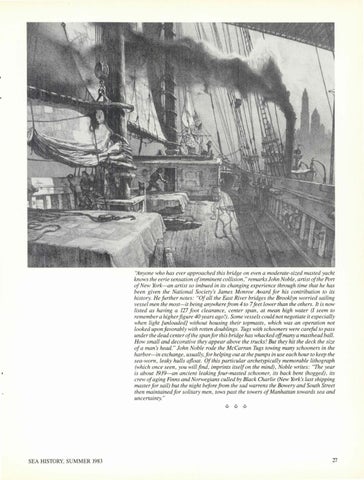'itnyone who has ever approached this bridge on even a moderate-sized masted yacht knows the eerie sensation ofimminent collision," remarks John Noble, artist ofthe Port of New York-an artist so imbued in its changing experience through time that he has been given the National Society's James Monroe Award for his contribution to its history. He further notes: "Of all the East River bridges the Brooklyn worried sailing vessel men the most-it being anywhere from 4 to 7feet lower than the others. It is now listed as having a 127 foot clearance, center span, at mean high water (I seem to remember a higher figure 40 years ago!). Some vessels could not negotiate it especially when light [unloaded] without housing their topmasts, which was an operation not looked upon favorably with rotten doublings. Tugs with schooners were careful to pass under the dead center ofthe span for this bridge has whacked offmany a masthead ball. How small and decorative they appear above the trucks! But they hit the deck the size of a man's head." John Noble rode the McCarran Tugs towing many schooners in the harbor-in exchange, usually.for helping out at the pumps in use each hour to keep the sea-worn, leaky hulls afloat. Of this particular archetypically memorable lithograph (which once seen, you will.find, imprints itself on the mind), Noble writes: "The year is about 1939-an ancient leaking four-masted schooner, its back bent (hogged), its crew of aging Finns and Norwegians culled by Black Charlie (New York's last shipping master for sail) but the night before from the sad warrens the Bowery and South Street then maintained for solitary men, tows past the towers of Manhattan towards sea and uncertainty."
SEA HISTORY, SUMMER 1983
